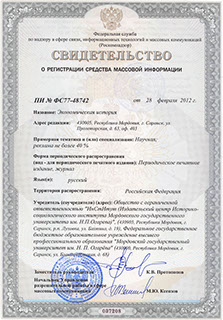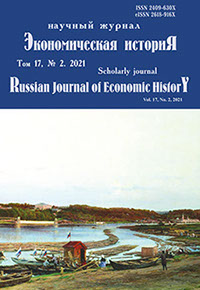Экономическая историЯ
Russian Journal of Economic History
ISSN 2409-630X (Print)
ISSN 2618-916X (Online)
Expert board:
- Scientific Council of RAS on economic history;
- Research and Educational Center «The economic history of Central Russia and the Middle Volga region» of Ogarev Mordovia State University;
- Center of Economic History of Lomonosov Moscow State University
Navigation
Certificate of registration

ISSN 2409-630X (Print), ISSN 2618-916X (Online)
DOI: 10.15507/2409-630X.053.017.202102.161-177
УДК 94(47+57); 338.45
Ivan V. Zykin
Technological Institute (branch) of the National Research Nuclear University “MEPhI” (Lesnoy, Russia),
e-mail: zivverh@mail.ru
Behind the Five-Year Plan: the Timber Processing Complex of the USSR in Annual Plans for 1935–1937
Introduction. The timber processing complex became an important component of the project of “socialist industrialization” of the late 1920s – early 1940s in the Soviet Union. The first five-year plan was not implemented by the industry, despite a significant increase in indicators compared to the period of the “new economic policy”. The development of the forest industry in the second five-year plan should have become more balanced and not lose dynamism. During this period, the economic structure of the industry was relatively homogeneous. An analysis of the indicators of annual national economic plans in the context of the second five-year plan becomes relevant. Historiography of the period of “socialist industrialization” and, in particular, 1933–1937 consists mainly of studies of foreign and domestic scientists on the Soviet economy and works on the history of the forest industry of certain regions. Materials and Methods. The theoretical and methodological basis of the study is the concept of modernization. Based on the information of the second five-year plan and annual plans, series of data on the development of the timber processing complex of the Soviet Union were formed. Results. At the beginning of the second five-year plan, the industry experienced stagnation of production and financial indicators, failure to fulfill annual plans. Then, as capital investments increased, the construction of enterprises was completed, capacities were developed, new forms of socialist competition developed, the timber processing complex demonstrated a significant improvement in the results of activities. Labor productivity increased at a relatively high rate in the fields of machining and deep processing of wood, but slowly grew in the field of timber harvesting. Unsatisfactory tasks were performed to reduce the cost of production. Conclusions. The main volumes of work in the timber processing complex were carried out by the Narkomles (People’s Committee of Forest Industry) of the USSR. In 1935–1936 it became possible to approach the target values of the second five-year plan, which, however, was not fully implemented due to the beginning of mass repressions and the transfer of part of the enterprises to forced labor camps. Summing up the planned and actual results of the timber processing complex for 1933–1937 showed that the industry fulfilled the five-year plan by 80–90 %, and in some areas surpassed it.
Keywords: timber processing complex, industrialization, second five-year plan, Narkomles of the USSR, indicators, gross products, labor productivity.
For citation : Zykin I. V. Behind the Five-Year Plan: The Timber Processing Complex of the USSR in Annual Plans for 1935–1937. Ekonomicheskaya istoriya = Russian Journal of Economic History. 2021; 17(2): 161–177. (In Russ.). DOI: 10.15507/2409-630X.053.017.202102.161-177.
© Ogarev Mordovia State University. History and Sociology Institute, 2017
68, Of. 411, Bolshevistskaya St., 430005, The editorial office of the scholarly journal «Russian Journal of Economic History»
Tel.: (8342) 24-25-90; 27-07-11, Fax: (8342) 24-25-90, E-mail: jurnal-econom-hist@isi.mrsu.ru
Designed by A. Napalkov, Email: napalkov@isi.mrsu.ru

